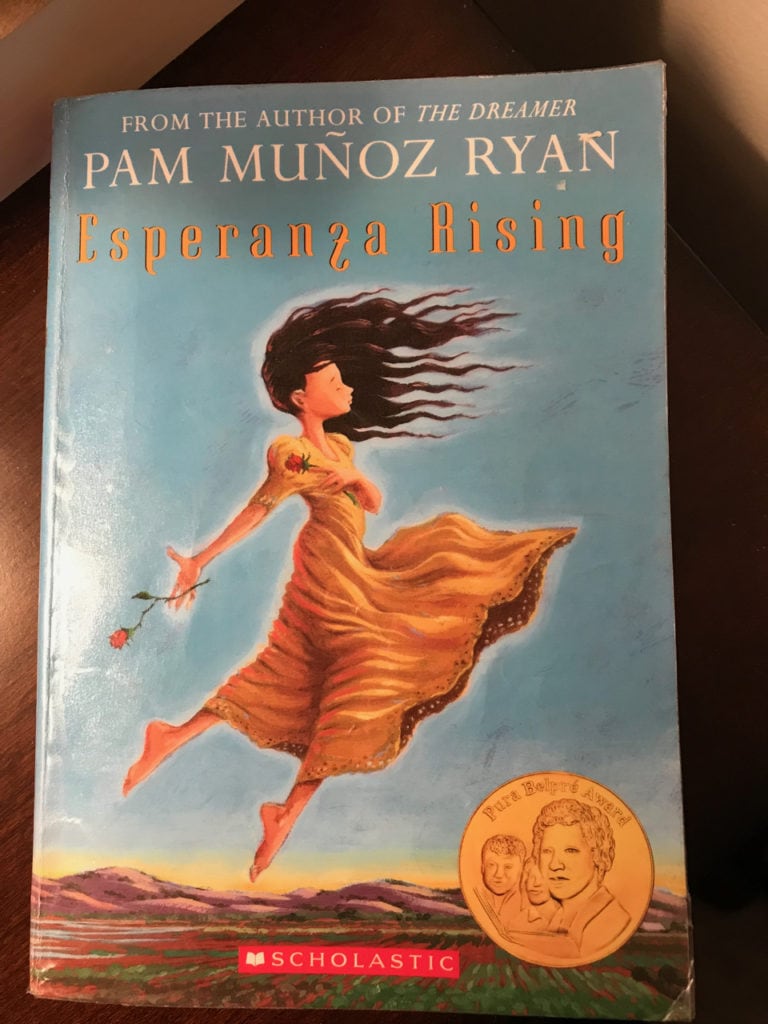 [Esperanza] watched the silver crochet needle dance back and forth in her grandmother’s hand. When a strand of hair fell into her lap, Abuelita picked it up and held it against the yarn and stitched it into the blanket.
[Esperanza] watched the silver crochet needle dance back and forth in her grandmother’s hand. When a strand of hair fell into her lap, Abuelita picked it up and held it against the yarn and stitched it into the blanket.
“Esperanza, in this way my love and good wishes will be in the blanket forever. Now watch. Ten stitches up to the top of the mountain. Add one stitch. Nine stitches down to the bottom of the valley. Skip one.”
Esperanza picked up her own crochet needle and copied Abuelita’s movements and then looked at her own crocheting. The tops of her mountains were lopsided and the bottoms of the valleys were all bunched up.
Abuelita smiled, reached over, and pulled the yarn, unravelling all of Esperanza’s rows. “Do not be afraid to start over,” she said.
—Esperanza Rising by Pam Muñoz Ryan, Scholastic paperback edition, ISBN 978-0-439-12042-5, 2007, pp. 14–15.
A Few Opening Thoughts
If you haven’t read this book yet, let me tell you that it belongs on your TBR list. Go ahead. Write it down. I’ll wait.
The clamor over immigration these days is not as new as we want to believe. It’s been a hotbed issue for decades. This tale of a young Mexican girl who has to flee her home with her mother and a group of family friends for the safety of America is based on the author’s grandmother’s immigration experience. Migrant farm workers form the backbone of Ryan’s family tree. They worked hard to make a home for their children, grandchildren, and great-grandchildren. Even though the story takes place during the Great Depression decade of the 1930s, the obstacles for immigrants are still looming and scary.
If you have a young person in your life, probably aged 10 or older, do them a favor and buy them this book. Then have a conversation about immigration. Perhaps dig up your own family history and share it. Many of us can trace our roots to an immigrant who dared to risk everything to start over in America. Now, more than ever, this conversation needs to happen.
Crochet Lesson #1 (Lección de Ganchillo Número Uno)
Imperfections create personalization.
Those of us who work with yarn—usually as knitters or crocheters—find ourselves pick, pick, picking things out of the yarn as we stitch. It might be a piece of lint, a cat hair, or one of our own single tresses that clings to the fiber. We see that as an imperfection, an intrusion into the project that we’re working so hard to make. Pick, pick, pick.
From now on, I want to think like Abuelita. I want my strands to embrace the yarn if they fall into my work. I want to make every stitch a prayer for the person who will receive the gift I’m creating. I’ll be less worried about perfection so I can enjoy the stitches, the rows, the mountains and the valleys. Will you?
Crochet Lesson #2 (Lección de Ganchillo Número Dos)
Ah, those mountains and valleys. I’ve spent time in both places—and so many years in between. I’ll bet you have, too. Those valleys are tough. They feel dark, lonely, and long. If you can envision the crochet pattern Abuelita uses (it looks exactly like the photo above), you will see that the deepest part of the valley is only one stitch away from heading up toward the mountain top. Just one stitch. Maybe that’s all you can manage some days. That one thing that moves you slightly up, changes the angle oh-so-little, but oh-so-not-in-the-deepest-part-of-the-valley. Maybe it’s taking a walk. Calling a friend. Starting a new book (read or write). Steeping a cup of tea and watching a favorite old movie. Just one little stitch. Crochet hook in, yarn over, pull through. Pull through.
Crochet Lesson #3 (Lección de Ganchillo Número Tres)
Abuelita smiled, reached over, and pulled the yarn, unravelling all of Esperanza’s rows. “Do not be afraid to start over,” she said.
I wish we could undo our mistakes as simply as pulling on a string. We can’t. However, we can try again, over and over if necessary. Here are some ways to do that:
- Apologize sincerely when wrong.
- Admit when we’ve made a mistake.
- Make atonement when possible. (AA’s Twelve-Steps followers depend on this to maintain sanity and sobriety. We all would do well to practice this step, too.)
- Not take failure to heart.
- Remember that everyone fails, and probably a lot more often than we realize.
- Forgive yourself.
- Give yourself permission to mess up, especially if it means you can take risks doing something you’ve always wanted to do.
- Swear. Punch a pillow. Take a break. Doodle. Journal. Mow the lawn. Clean the kitchen. Do something to get the negative feelings out (don’t stuff and deny them—that will only make you depressed and even sick) and then start again when you’re ready.
Do you know someone who might be encouraged by this post? Send it to them. They don’t have to join the blog, make a comment, or do anything at all. Just receive some encouragement—especially if they’re deep in a valley right now.
Those who want to follow my blog can do so by adding your information here:



